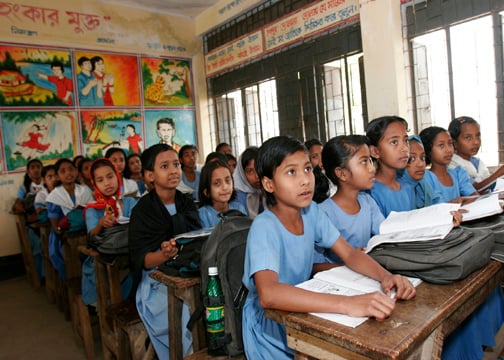Shaheb Mia, 17, collects rubbish on the crowded streets of Dhaka, the capital. Although he can write his name in Bengali and English and count, he has never learned to read or write.
“I went to our village school for three years. Then my father abandoned us. My mother and I left our home for Dhaka. In Dhaka there is no time for me to go to school. If I go to school, I starve,” he explained.
Ratna Begum, 14, of Damai village of Kahalu sub-district of northwestern Bogra district, went to the Buroil Government High School for four years only to drop out. “I was 12 years old and my father would not let me go out of the house at that age. I did not enjoy going to school. The school was like a cowshed. Doors and windows were broken and benches were broken too. The teachers were not regular either. There was no separate toilet for girls. So I lost interest,” she added.
Primary school dropout rates in Bangladesh, with a population of 150 million, have always been high, but new research suggests numbers are increasing.
According to a study conducted by 10 NGOs, with the Commonwealth Education Fund, the dropout rate has increased from 33 percent in 2002 to 47 percent in 2006. Moreover, the net enrolment of six to 10-year-olds declined to 93 percent in 2005 from 97 percent in 2002.
The downward trend took place during the second primary education development programme (PEDP-II), an ambitious, US$7 billion project funded by the government (63.9 percent) and development agencies (36.1 percent). The project runs from 2003 to 2009.
According to the US Agency for International Development, a partner in the PEDP, Bangladesh’s primary-school dropout rate remains unacceptably high, especially for children living in poverty and from minority families.
 Photo: David Swanson/IRIN  |
| Some 16.5 million children attend primary school in Bangladesh today |
The Ministry of Primary and Mass Education reckons that on average, students take 6.6 years to complete the five-year primary school programme.
“Of those who do graduate from primary school, most do not acquire the nationally defined basic competencies,” Dinar Kamal, an assistant teacher of the Mirzapur Government Primary School in southeastern Feni district, noted.
Bangladesh has 16.5 million children attending 80,395 official primary schools and employs more than 320,000 teachers, with many secondary level schools having primary facilities.
There are also more than 20,000 informal primary schools run by NGOs and the private sector where children are taught to the third grade.
More than 65 percent of primary schools are under direct government management, with the rest registered as non-governmental schools, receiving assistance and support from the government.
“Primary level student enrolment is increasing but the quality of education is not. Lack of qualified teachers and poor school facilities in terms of the number of schools, classrooms, libraries and playgrounds are responsible for poor quality education at primary schools,” said Mohammad Badal Miah, an assistant professor of Teachers’ Training College of Mymensingh, north of Dhaka.
And though the government had increased funding for education, the expenditure per pupil is still low.
“Teachers are poorly trained and paid. Teaching methods and materials are generally sub-standard, especially in government schools. Schools are in poor condition and detrimental to learning,” Miah said.
Outlook
 Photo: David Swanson/IRIN  |
| There are more than 20,000 non-formal primary schools in Bangladesh |
With assistance from the UN Children’s Fund (UNICEF), the government produces and distributes free books and education kits to primary school students.
“Bangladesh has made remarkable progress in primary education over the past few years. This has been due to the introduction of compulsory primary education (CPE) in 1992 along with many other innovative educational initiatives at this level,” Ohidur Rashid, a UNICEF project officer for primary education told IRIN.
Under PEDP-II, two classrooms were built in 7,392 schools, toilets in 7,168 schools and wells in 7,168 schools, but much more is needed.
The NGO report suggested 6 percent of national revenue be allocated to primary education against a World Bank recommendation of 4 percent. In reality, Bangladesh spends 2.4 percent - the lowest in South Asia.
Meanwhile, the government and donors’ representatives have begun a mid-term review to assess the progress of PEDP-II.
sa/ds/mw
This article was produced by IRIN News while it was part of the United Nations Office for the Coordination of Humanitarian Affairs. Please send queries on copyright or liability to the UN. For more information: https://shop.un.org/rights-permissions





